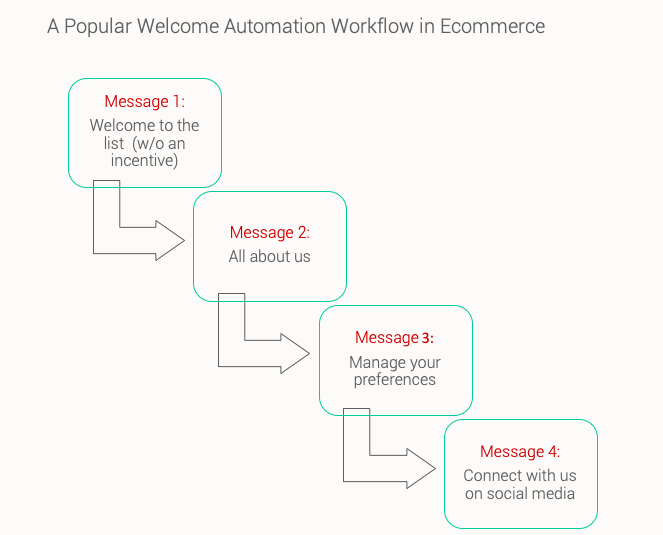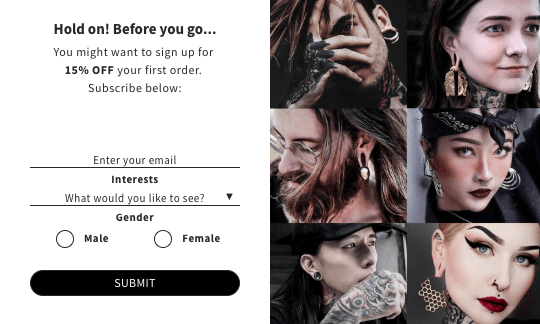Welcome series messages are some of the most profitable lifecycle marketing messages in a retailer’s email automation toolbox . But are they as effective as they can be? Chances are they are not, and here’s why.
The purpose of a welcome series is to onboard new email subscribers with messages that turn them into customers. Most retailers who look to conventional welcome email best practices try to do this by sending messages that showcase their brand’s authenticity, only to wind up sending the same, generic welcome series messages as their competitors. But there’s nothing authentic about sending the same message to every new subscriber.
Epsilon research indicates 80% of consumers are more likely to make a purchase when brands offer personalized experiences. In other words, personalization is now a standard expected from DTC brands and retailers.
Then why is it that when it comes to automated lifecycle messages personalization becomes an afterthought?
Retailers today need a welcome series that makes their brand stand out and that has real revenue-driving potential. To do this, retailers need to rethink how they can deliver fresh and engaging messages to new subscribers. Here are some ways this can be done.
Determine What Messages Are Worth Including into Your Welcome Series
Brands that follow traditional best practices usually end up with a welcome series that looks something like this:

If three retailers send you this same welcome series, how do you choose who to purchase from? You may also find yourself to lose interest in the messaging and brand more easily.
Retailers should analyze their messages and really think about what matters to consumers at this stage in their journey. Looking at this example series, you might ask yourself the following questions:
1.Is your newcomer currently shopping? How can you guide them toward a purchase? Does your CTA help them along their journey? What information matters most to your customers ?
2. Is your brand story compelling enough that your new subscribers need to hear it? If not, product-oriented information may be able to create more value .
3. Why would a customer choose you and not your competitor? Whether it’s customer service, eco-friendly products, flexible return policies, speed and cost of shipping, or unique features, use your competitive differentiators to guide what information should be communicated in your welcome series messages.
4. Don’t waste your messages and attention on things that are obvious or unnecessary nowadays—like social media invite messages. Social media is an everyday part of consumers’ lives and they’ll find you, along with influential social proof, if they want.
5. Will you immediately use the information you collect ? If you ask customers to manage their preferences but do not immediately use the information to personalize emails, don’t ask for it. Otherwise, you’re setting expectations that you can’t meet.
Remember, your goal is to turn a new subscriber into a new customer. Some value-add messaging that would be helpful for the customer might be:
- Your customer-friendly return policy
- An incentive for the first-time purchase
- Recommended products/product categories
- Fulfillment options, such as speed and cost of delivery, BOPIS and curbside pick-up.
- Payment options such as buy now pay later
- A link to the landing page with more questions about the subscriber and their interests. (ONLY if you will use the information immediately)
- How-to guides, FAQs or other related content
- Social media content as a means to influence (Using social media posts to highlight products)
- User-generated content as a form of social proof (product reviews, testimonials, socially-shared posts, etc.)
- Photos or videos telling your brand story (Only tell your brand story if it creates value to your customers. Otherwise, focus on personalized, product-oriented information)
Pay closer attention to user-generated content. Just because a social invite message no longer makes sense for most, it doesn’t mean you should avoid using social media inside of your series—it should definitely be one of the components in the welcome series. But instead of an invite message, consider highlighting customers’ posts from Instagram or TikTok where they talk about your brand or products. This form of social proof can influence not only purchases but also drive awareness of your social channels.
By assessing the elements listed above, you will be able to craft more engaging messaging that reinforces the value of your brand, addresses the vast majority of first-time purchaser concerns, and builds consumer confidence.
Personalize Welcome Messages by Identifying A Customer’s Intent
We mentioned some ways to think of what matters to new email subscribers, but that alone won’t make the content relevant. To create a relevant welcome series, we need to send messages that match customers’ intentions.
For cart abandoners, it’s easy to guess what they want—they told us by placing items in their cart. For new subscribers, it’s not as apparent. As marketers, we need to step into their shoes. Why were they on our site? What were they shopping for? What information might they need to lead them toward a purchase decision?
Luckily, this information is not only accessible but can also be put to immediate use inside of a welcome series. Here are some examples.
Collect Information at Signup
Method 1.
As consumers, we don’t visit a store to buy everything. We’re generally looking for something specific: either a new casual dress, a day cream for sensitive skin, or new shoes for that blue suit in your closet, etc.
People browse product categories according to their shopping intentions. Using forms to capture this intent allows retailers to tag consumers based on that info and deliver a better customer experience, all the way from the signup through the entire welcome series.
For example, take the new subscriber who was browsing the saltwater fishing section of your website. A general welcome series might communicate messaging about the other products they sell, such as freshwater or fly fishing products and brands. This generic welcome series may not only be irrelevant for the new subscriber but may not help them down their path to purchase.
Method 2.
A second method of collecting new subscriber data is to ask them during the signup . Asking for simple pieces of information such as gender, SMS number, or category of primary interests, may be all the information you need to personalize your welcome messages. By keeping it short and simple, you might find how willing consumers are to share this information.
In this example, you can see the retailer asks for gender and primary category of interest. Knowing this, marketers can create welcome messages that are relevant to those consumers, such as with appropriate product recommendations, hero images, discounts, or CTAs.

Find out more about how to collect and use this data to create a more robust welcome series.
Don’t Rely on One Channel to Reach Your Newcomers
What should you do if the new subscriber opens your first email in the series, doesn’t redeem your offer, and then ignores the rest of the welcome series emails? Well, if you are relying on only emails in your welcome series, there’s not much you can do.
This is the perfect reason to integrate more channels in your marketing program. Our research shows that the purchase rate of omnichannel campaigns is 287% higher than single-channel campaigns. Knowing that you can employ text messages, push notifications, or other channels into your welcome series provides you the ability to improve customer outreach and add greater personalization to your welcome series.
Consumers and retailers alike are increasingly adopting SMS as a preferred communication channel, and by including text messages into your welcome series workflow, you will be able to better reach out to your newcomers and keep them engaged with your brand. The same Omnisend research showed that including SMS into the workflow improved conversion rates by 47.7%. Not bad, huh?
______________
The time when sending a standalone welcome message or a generic welcome series to your new subscribers has passed. When building and reviewing your welcome series, try to think of your main competitive differentiators and the real value you provide to the customer at that moment. Remember, your primary purpose is to lead the new subscriber toward a purchase.
By approaching customers via their preferred channels and providing them relevant and engaging content, you are sure to turn new subscribers into customers.
